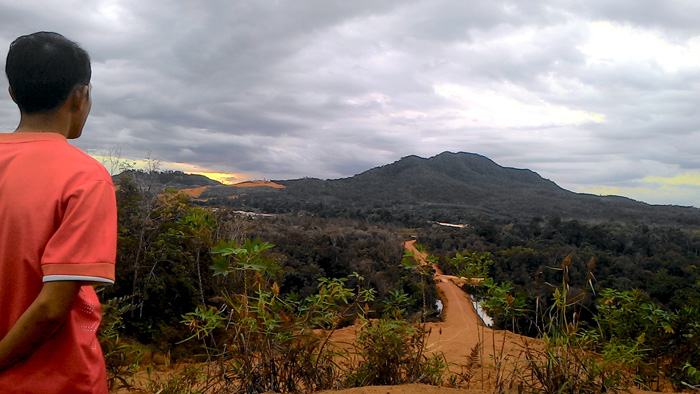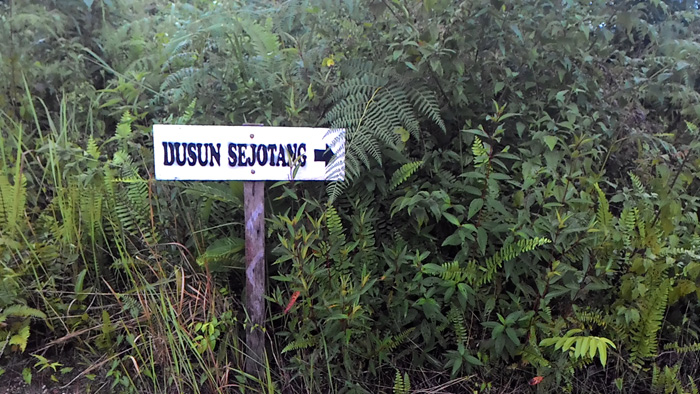
April 28, 2015, Aseanty Pahlevi, Sanggau, West Kalimantan
Pius Tomi (35) and several residents of Sejotang Village gathered. In the living room of Tomi’s residence, they consulted, discussing the fate of their village and indigenous forest on Mount Sebayan, which had been investigated, and had been included by the local government in the palm oil company concession.
Sejotang Village is around 20 kilometers from Tayan Hilir District, Sanggau Regency, West Kalimantan. The village is in charge of seven hamlets namely Sejotang, Semenduk, Batang Besi, Jeramun, Yangko, Unga, and Pimple. While Tomi, is the village chief of Sejontang who was just elected six months ago. He is responsible for 515 households or 1,931 people who live in the village.
According to Tomi, on Mount Sebayan, there is Tembawang community. Tembawang is a Dayak community term, for land planted with fruit. On Mount Sebayan there is also a spring, which is a source of clean water for residents flowing into the village through pipes.
Together with Jaya Adat, the structure of the Dayak Indigenous Council at the village level, residents have carried out the mapping of the Sejotang indigenous forest. “So far, our 300 hectares indigenous forest has only been mapped 100 hectares,” said Tomi.
Residents argue participatory mapping of customary forests must be done. Bearing in mind, the area of Sejotang Village has been given generously by the local government for palm oil company concessions. “The government issues palm oil business licenses on community land. This is what made us take the initiative to do the mapping. If it is finished, we will submit it to the regional government, so that our area is excluded from the company’s concession, which I am still investigating, “Tomi added.
Secretary of the Dayak Customary Council, Julian (50) stated, only Sejotang Village and Subah Village in the Tayan Hilir area could still be saved by their indigenous forests. Others are gone. In fact, Tayan Hilir has a good landscape. There are hills, lakes, rivers, and of course forests. “Unfortunately, due to this area, there is a bauxite content, in the near future PT. Antam, apart from of course the palm oil company that is ready for operation,” he said.
Julian himself who lives in Jaang Hamlet, Lalang Village, has been in rebellion. The backyard of his house has been claimed to be included in the concession of oil palm companies. In fact, land cultivation has been carried out. “I’m confused as to why this could be,” he explained.
Hermawansyah, Director of the Swandiri Institute, said that in this participatory mapping, they only accompanied the Sejotang Community. “We use drones which are still operated by colleagues from the Swandiri Institute. While the original data is from the community. ”
Hermawan explained, in participatory mapping, the community was trained first to use GPS (Global Positioning System) to mark their territorial boundaries, from villages to indigenous forests. Furthermore, the data is used as a drone flight route and photographed from the air. “We did this mapping after being contacted by the Dayak Indigenous Council to assist them.”
Certainly, the use of drones is not to eliminate the way mapping has been done by indigenous peoples so far. Moreover, eliminating the positive values that they uphold. “It is not that. We just make it easier. If without drones, mapping one village can take months, with drones can be done in a few hours.” added Hermawan.

Hapy Hendrawan, a Swandiri Institute Researcher, hopes that the participatory map made by the Sejotang Community will be accommodated by the Sanggau Regency Government. “This map reflects the problems on the ground,” he said.
In the near future, Hapy said that the community will hold a hearing with members of the Sanggau Regency DPRD. The goal is for the Sanggau District Government to immediately establish indigenous forests belonging to the Sejotang and Subah Communities. “Because the requirement to get recognition of indigenous forests is by removing the status of these forests from state forests through regional regulations. This initiative is expected to be an example for other indigenous communities in West Kalimantan,” said Hapy.